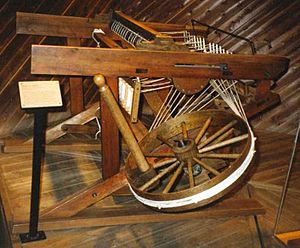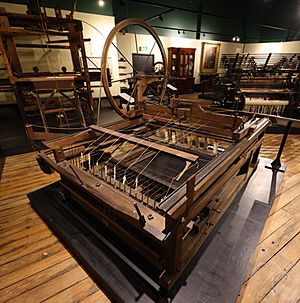Spinning jenny facts for kids
The spinning jenny was a very important machine invented during the early Industrial Revolution. It was a special kind of spinning frame that could spin many threads at once. This invention helped change how cloth was made.
James Hargreaves invented the spinning jenny in England around 1764. Before this, people spun yarn one thread at a time. The spinning jenny allowed one worker to spin eight or more threads at the same time. As the machine got better, it could even spin 120 threads!
This invention made it much faster to produce cloth. It also helped start the factory system, where many people worked together in large buildings to make goods.
Contents
How the Spinning Jenny Changed Things
The spinning jenny was invented by James Hargreaves. He was born around 1720 in a town called Oswaldtwistle, near Blackburn, England. Blackburn was known for making "Blackburn greys," which were cloths made from linen and cotton.
At that time, it was hard to make enough cotton yarn to keep up with the demand. Weavers, who made cloth on looms, had become much faster thanks to an invention called the flying shuttle by John Kay in 1733. This meant weavers needed a lot more yarn than spinners could produce.
Hargreaves spent time thinking about how to make spinning faster. His spinning jenny helped solve this problem by letting spinners make much more yarn.
How It Worked
The spinning jenny was a metal frame with several wooden spindles (like the part of a spinning wheel that holds the yarn). Here's how it worked:
- Eight or more bundles of cotton fibers, called rovings, were attached to the frame.
- These rovings went through two wooden bars that could be clamped together.
- The spinner would pull these bars with one hand, which stretched the threads.
- With the other hand, the spinner would quickly turn a wheel. This made all the spindles spin at the same time, twisting the stretched threads into yarn.
- When the bars were moved back, the newly spun yarn wound onto the spindles.
- A special wire helped guide the threads onto the right spot on the spindle.
The spinning jenny made it possible to produce a lot more yarn, but the yarn it made wasn't always super strong. Later, Richard Arkwright invented the water frame, which used water-power to make stronger yarn.
The Cotton Business in England
In the 17th century, England was famous for its woollen cloth. Making cotton cloth was much smaller. Laws were even passed to protect the wool industry and limit cotton imports.
However, cheap calico prints from India became very popular. Even with laws trying to stop them, people found ways around them. For example, they imported plain cotton cloth and then printed designs on it in England.
By 1736, a law called the Manchester Act allowed the use of colored cotton threads with linen. This created a big demand for woven cloth. By 1764, England was importing a lot more cotton.
Before big factories, people often worked from home. A weaver might buy yarn from neighbors who spun it. It took many spinners to provide enough yarn for one weaver. Families would often farm a little and also spin and weave.
Around 1740, things started to change. Business owners would give raw cotton to weavers, who would then organize the spinning and weaving at home. The finished cloth was then collected by the business owner.
When John Kay invented the flying shuttle in 1738, it made weaving much faster. One weaver could now make twice as much cloth! This was great for weavers, but it meant there wasn't enough yarn to keep up. This shortage of yarn is what pushed people to invent machines like the spinning jenny. It was a big step that helped start the Industrial Revolution.
Success of the Spinning Jenny
James Hargreaves tried to keep his invention a secret at first. He made several machines for his own business. But as more yarn was produced, the price of yarn dropped. This made many spinners in Blackburn angry because it affected their jobs. Eventually, some people broke into his house and smashed his machines.
Hargreaves had to move to Nottingham in 1768. There, he started a new business making jennies in secret. On July 12, 1770, he officially got a patent for his invention, the Spinning Jenny.
By this time, many people in Lancashire were already using copies of his machine. Hargreaves tried to take legal action against them. The manufacturers offered him money, but the case eventually failed because it was found that he had sold some machines before getting his patent.
The spinning jenny was a success because it could hold many balls of yarn. This meant it made more yarn in less time and cost less to produce. It worked especially well because the flying shuttle had already made weaving faster, creating a need for more yarn.
The spinning jenny was used in the cotton industry until about 1810. It was eventually replaced by an even better machine called the spinning mule.
The Name: Origin and Myth
There's a popular story about how the spinning jenny got its name. The story says that one of James Hargreaves' daughters (or his wife) named Jenny accidentally knocked over their spinning wheel. The wheel kept working, but the spindle was now standing upright. Hargreaves supposedly realized that the spindles didn't have to be horizontal and could be placed vertically in a row.
However, church records show that Hargreaves had several daughters, but none were named Jenny. His wife wasn't named Jenny either. A more likely explanation is that "jenny" was a short way of saying "engine."
Another story says that a man named Thomas Highs claimed to be the inventor, and the story about the knocked-over wheel was told using his wife's name. There's also a myth about another inventor, Thomas Earnshaw, who supposedly destroyed his spinning machine because he feared it would take jobs away from poor people.
See also
 In Spanish: Hiladora Jenny para niños
In Spanish: Hiladora Jenny para niños
- Cotton mill
- Luddite
- Spinning mule
- Textile manufacture during the Industrial Revolution
- Textile manufacturing
- Timeline of clothing and textiles technology



